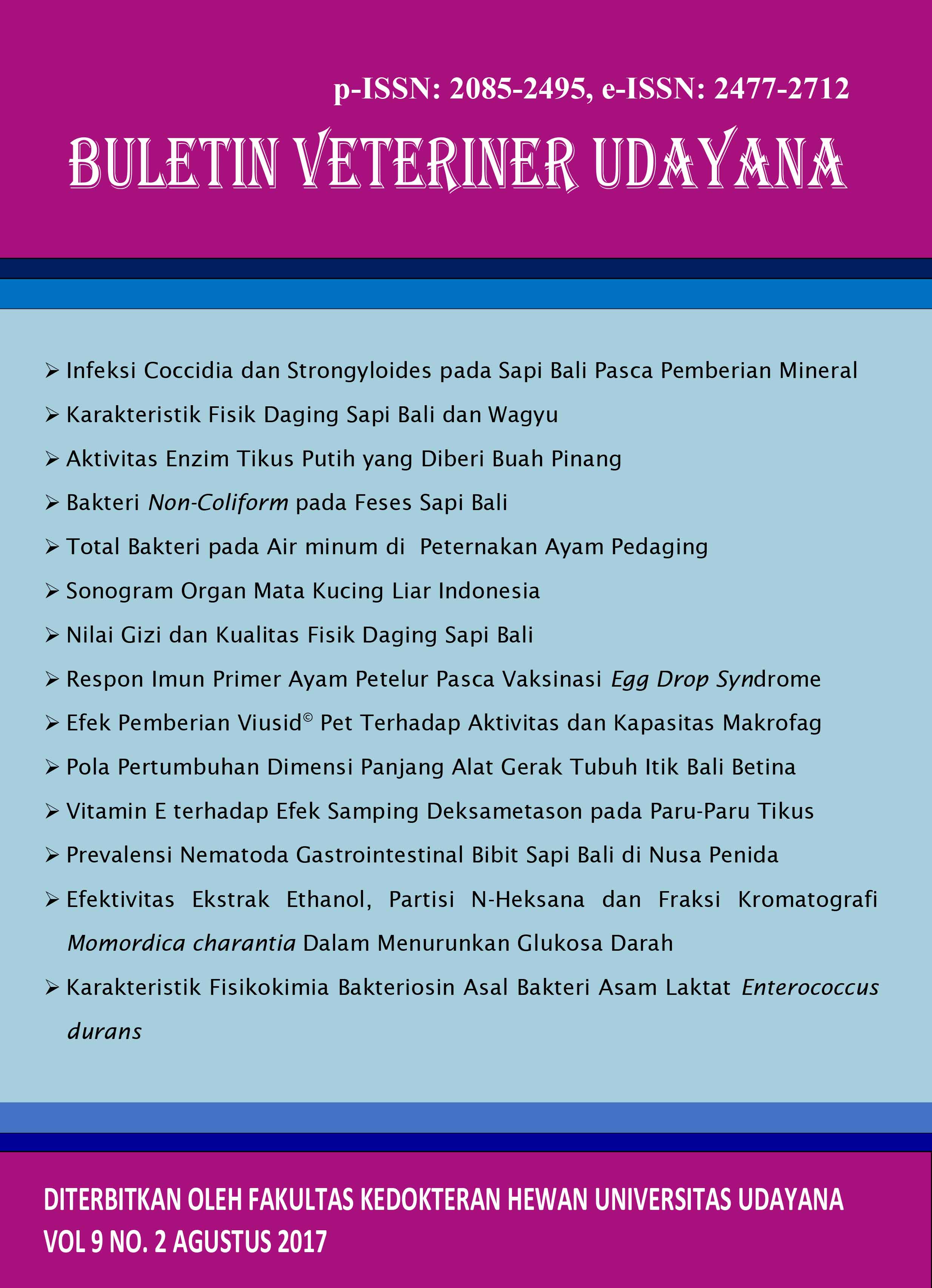THE PREVALENCE OF GASTROINTESTINAL NEMATODES OF BALI CATTLE BREEDERS IN NUSA PENIDA
Abstract
Nusa Penida is a pure breeding area of bali cattle, in which the cattle are mainly kept in conventional maintenance system and potentially infected by parasite, especially gastrointestinal nematodes. This study aims were to determine the prevalence and type of gastrointestinal nematodes in bali cattle breeders in Nusa Penida. Fecal samples were taken from 50 bali cattle breeders kept in cages (simantri) and another 50 samples were from cattle not kept in cage. The floating method was used for morphological examination and prevalence, the data was analyzed with descriptive analysis. The results showed, the prevalence of bovine gastrointestinal nematodes in Nusa Penida was 25%. The prevalence of nematode infection in bali cattle that kept cages was lower compared to the cattle that were not kept in cage. Strongyloides papillosus and Capillaria bovis were the gastrointestinal nematodes found in the infected cattle.
Downloads
References
Direktorat Perbibitan Ternak Direktoral Jenderal Peternakan dan Kesehatan Hewan Kementrian Pertanian dan Kesehatan Hewan. 2014. Penguatan pembibitan sapi asli/lokal di pulau terpilih (Pulo Raya, Pulau Nusa Penida, dan Pulau Sapudi) dan penguatan pembibitan sapi potong di kabupaten terpilih (Siak, Pasaman Barat, Lampung Selatan, Kebumen, Barito Kuala, Barru, Gunung Kidul dan Lombok Tengah). Jakarta.
Dimander SO, Hoglund J, Uggla A, Sporndly E, Waller PJ. 2003. Evaluation of gastrointestinal nematode parasite control strategies forrst-season grazing cattle in Sweden. Vet Parasitol 111: 193–209.
Fadli M, Oka IB, Suratma NA. 2014. Prevalensi Nematoda Gastrointestinal padaSapi Bali yang DipeliharaPeternak di DesaSobangan, Mengwi, Badung. Indonesia Medicus Veterinus 3(5): 411-422.
Forbes AB, Huckle CA, Gibb MJ, Rook AJ, Nuthall R. 2000. Evaluation of the effects of nematode parasitism on grazing behaviour, herbage intake and growth in young grazing cattle. Vet Parasitol 90: 111–118.
Gasbarre LC, Leighton EA, Sonstergard T. 2001. Role of the bovine immune system and genome in resistance to gastrointestinal nematodes’, Vet Parasitol 98. 51–56.
Junaidi M, Sambodo P, Nurhayati P. 2014. Prevalensi Nematoda pada Sapi Bali di Kabupaten Manokwari. JSV 32 (2).
Moyo DZ. 2006. An Abbatoir Study of Prevalence and Seasonal Fluctutions of Gastrointestinal Nematoedes of Cattle in the Midlands Province, Zimbabwe. J Anim Vet Sci 1(1):37-40.
Mustika I, Riza ZA. 2004. Peluang pemanfaatan jamur Nematofagus untuk mengendalikan Nematoda parasit pada tanaman dan ternak. J Litbang Pertanian 23(4): 115
Novobilsky A, Mueller-Harvey I, Thamsborg SM, 2011. Condensed tannins act against cattle nematodes. J Vet Parasitol 182, 213–220.
Regassa F, Sori T, Dhuguma R, Kiros Y. 2006. Epidemiology of gastrointestinal parasites of ruminants in Western Oromia.Ethiopia. Int J Appl Res Vet Med 4(1).
Suwiti NK, Sampurna IP, Watiniasih, Puja N. 2013. Peningkatan Produksi Sapi Bali Unggul Melalui Pengembangan Model Peternakan Terintegrasi. LaporanTahap II penprinas MP3EI 2011-2015
Sugama IN, Suyasa IN. 2011. Keragaman Infeksi Parasit Gastrointestinal Pada Sapi Bali Model Kandang Simantri. Balai Pengkajian Teknologi Pertranian. Bali
Tim Pusat Kajian Sapi Bali-Unud. 2012. Sapi Bali Sumber Genetik Asli Indonesia. Edisi 1, Udayana University Press, Denpasar.
Yasa IWS. 2011. Identifikasi Cacing Nematoda Saluran Pencernaan pada Sapi Bali yang Dipelihara Di Petang ,Kecamatan Petang, Badung. Indonesia Medicus Veterinus 4(1): 81-85.
Yeung KJA, Smith A, Zhao A, Madden KB, Elfrey J, Sullivan C. 2005. Impact of vitamin E or selenium deciency on nematode-induced alteraons in murine intesnal funcion, Experimental Parasitol 109: 201–208
Zajac AM, Conboy GA. 2012.Veterinary Clinical Parasitology. 8th ed. John Wiley & Sons, Inc. UK.





